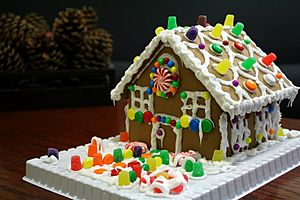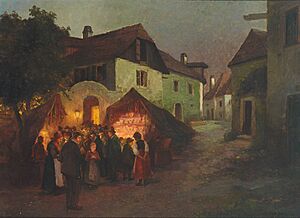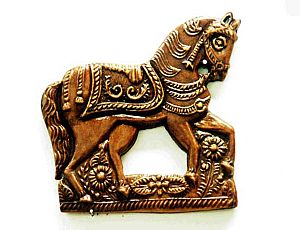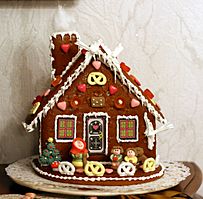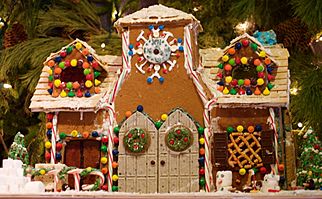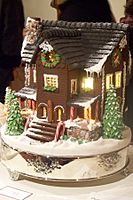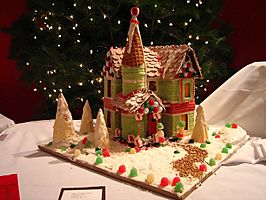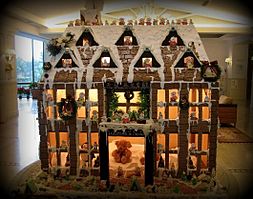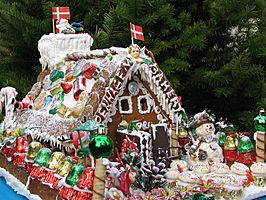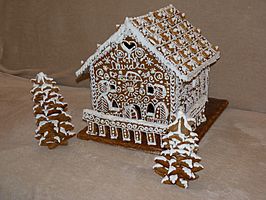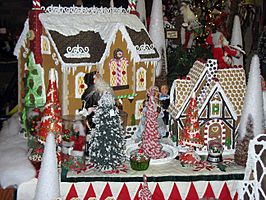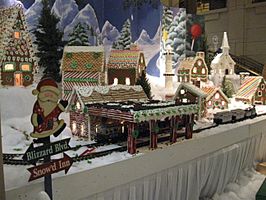Gingerbread house facts for kids
A gingerbread house is a fun treat shaped like a building. It's made from cookie dough, usually crisp gingerbread. The dough is cut and baked into pieces like walls and roofs. These sweet houses are often covered with colorful candies and icing. They are very popular Christmas decorations.
The idea of making decorated gingerbread houses began in Germany in the early 1800s.
Contents
History of Gingerbread Houses
People have enjoyed honey cakes since ancient Rome. Ginger has been used to flavor food and drinks for a very long time. It's thought that gingerbread was first baked in Europe around the late 1000s. This happened when crusaders returned from the Middle East. They brought back the idea of spicy bread. Ginger not only tasted good but also helped keep the bread fresh.
One old story says that an Armenian monk named Gregory of Nicopolis brought gingerbread to Europe in 992. He taught people how to make it in France.
Gingerbread, as we know it today, comes from old European cooking traditions. In the 1200s, monks in Germany shaped gingerbread into different forms. Bakers who made Lebkuchen (a type of gingerbread) were known in German cities like Ulm by 1296 and Nuremberg by 1395. Nuremberg became known as the "Gingerbread Capital of the World." In the 1600s, skilled bakers there made amazing gingerbread art.
During the 1200s, the custom of making gingerbread spread across Europe. German immigrants brought it to Sweden in the 1200s. Nuns in Sweden even baked gingerbread in 1444 to help with upset stomachs. Traditional gingerbread often uses honey as a sweetener. Spices like ginger, cinnamon, cloves, nutmeg, and cardamom give it its special flavor.
Gingerbread figurines, or small shaped cookies, have been made since the 1400s. In the 1500s, people started making gingerbread in the shape of figures. One famous example is from the court of Queen Elizabeth I of England. She had gingerbread figures made to look like her important guests!
Shaping Gingerbread and Its Uses
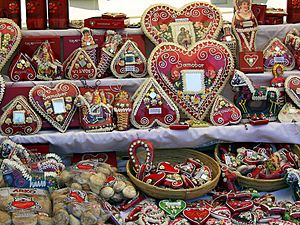
Bakers who made gingerbread often belonged to special groups called guilds. In many European countries, gingerbread bakers were a unique part of the larger bakers' guild. Making gingerbread became a recognized profession. In the 1600s, only professional gingerbread bakers were allowed to bake it. The only exceptions were during Christmas and Easter, when anyone could bake it.
In Europe, gingerbread was sold in special shops and at seasonal markets. These markets sold sweets and gingerbread shaped like hearts, stars, soldiers, babies, and animals. Gingerbread was often sold outside churches on Sundays. People bought gingerbread with religious pictures for special events like Christmas and Easter.
Decorated gingerbreads were given as gifts to adults and children. They were also given as a sign of love. People bought them especially for weddings, where gingerbreads were given to guests. A gingerbread showing a patron saint was often given as a gift on a person's name day. This is the day of the saint connected to their name.
It was also common to bake biscuits and paint them to use as window decorations. The most detailed gingerbreads were decorated with icing patterns, often in colors, and sometimes even covered with gold leaf. People also wore gingerbread as a good luck charm in battle. Some believed it could protect them from evil spirits.
Gingerbread was a significant form of art in Europe. Many cities were famous for carving gingerbread molds. These molds often showed real events, like new rulers and their partners. Large collections of these molds can be found in museums today. During winter, people in medieval times ate gingerbread pastries, often dipped in wine. This tradition continued in North America, where gingerbread cookies became popular Christmas tree decorations.
The tradition of making decorated gingerbread houses started in Germany in the early 1800s. Some researchers believe the first gingerbread houses were inspired by the famous Grimm's fairy tale "Hansel and Gretel." In the story, two children lost in the forest find an edible house made of bread with sugar decorations. After this book was published, German bakers started making decorated fairy-tale houses from lebkuchen (gingerbread). These became popular at Christmas. German immigrants brought this tradition to America. Other historians think the Grimm brothers were writing about something that already existed.
Gingerbread Houses Today

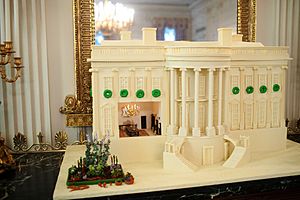
Today, the tradition of making gingerbread houses continues in many parts of Europe. In Germany, Christmas markets sell decorated gingerbread before Christmas. People often call them Lebkuchenhaus or Pfefferkuchenhaus. Making gingerbread houses is a Christmas tradition for many families.
They are usually made before Christmas using baked gingerbread dough pieces. These pieces are put together with melted sugar or royal icing. The roof "tiles" can be made of frosting or candy. The yard around the gingerbread house is often decorated with icing to look like snow.
A gingerbread house doesn't always have to be a house. It can be a castle, a small cabin, or another type of building like a church or a sports stadium. Other items, like cars or gingerbread men, can also be made from gingerbread dough.
In Sweden, gingerbread houses are often prepared on Saint Lucy's Day. Since 1991, the people of Bergen, Norway, have built a whole city of gingerbread houses each year before Christmas. It's called Pepperkakebyen, which means "the gingerbread village" in Norwegian. It's said to be the world's largest gingerbread city. Children under 12 can make their own house for free with their parents' help.
Guinness World Records
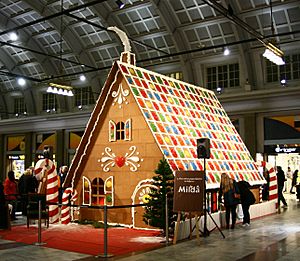
In 2013, a group in Bryan, Texas, USA, set a new Guinness World Record for the largest gingerbread house. It was a huge house with edible walls, measuring 2520 square feet (234 square meters). This amazing house was built to help a hospital. It had over 35.8 million calories! The ingredients included 2925 pounds (1327 kg) of brown sugar, 1800 pounds (816 kg) of butter, 7200 eggs, and 7200 pounds (3266 kg) of flour.
Jon Lovitch, a chef from the New York Marriott Marquis hotel, broke the record for the largest gingerbread village. His village had 135 homes and 22 businesses, plus cable cars and a train, all made of gingerbread. It was shown at the New York Hall of Science. The gingerbread town in Bergen, Norway, called Pepperkakebyen, is also a strong contender for a record.
Gallery
- Gingerbread houses
-
Gingerbread houses with Christmas tree
See also
 In Spanish: Casa de jengibre para niños
In Spanish: Casa de jengibre para niños


